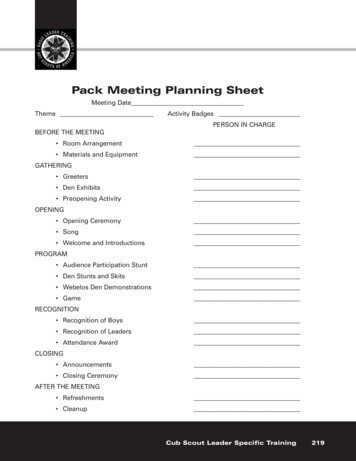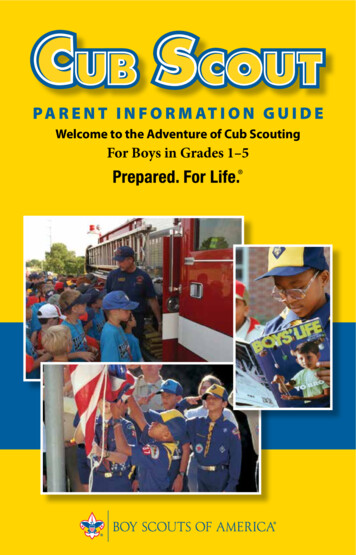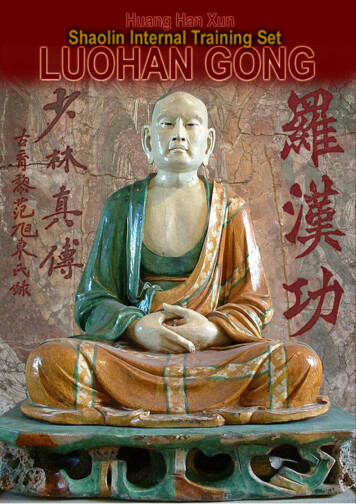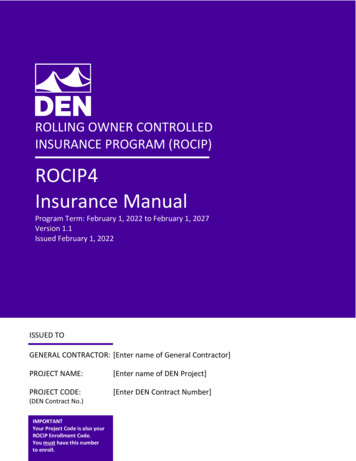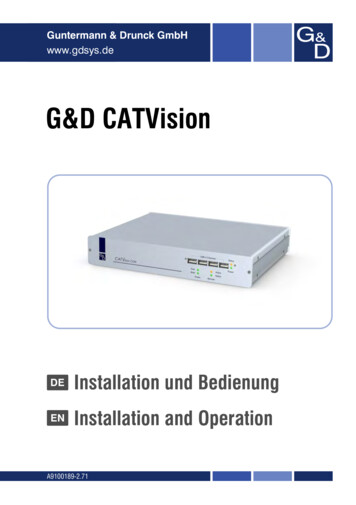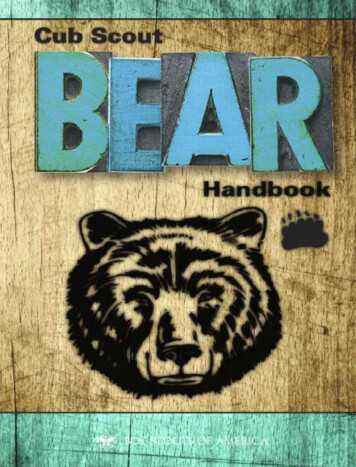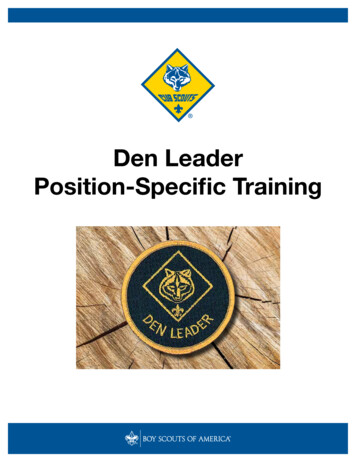
Transcription
Den LeaderPosition-Specific Training
515-2152015 Printing
Table of ContentsIntroduction. 4Gathering Time Activity. 7I. Before the Meeting Starts. 8II. Gathering. 10III. Opening. 13IV. Talk Time. 16V. Activities. 18VI. Closing. 20VII. After the Meeting. 21Appendix . 26 Characteristics of Cub Scouts. 27 Glossary of Scouting Terms. 30 Youth Protection Training. 32 Den Annual Adventure Plan. 33 Participant Course Assessment. 34Den Leader Position-Specific Training3
IntroductionThe Den Leader Position-Specific Training courseprovides Cub Scout den leaders with the basic information they need to conduct successful den meetings. The course is intended to be conducted in asmall group setting of about six to eight participants,similar to a den meeting.The course should take about two and a half to threehours to deliver. It may be offered in a single morning or evening session with a minimum of preparation necessary. It can be facilitated by unit, district,or council trainers.This syllabus is not meant to be read verbatim. Trainers should be familiar with the content and be able topresent it without reading. Experienced trainers canuse their own words, but must be sure to cover thecontent and meet all the learning objectives of each session. Key to the success ofthis training is the interaction among participants. It is important for trainers to observe participants throughout the training (especially during the hand-on activities)to be sure they have learned the topic.Training code C42 should be entered into the leader’s training records when the courseis complete. Den leaders who complete this course and Youth Protection training areconsidered “trained” as Tiger, Wolf, and Bear den leaders or as Webelos den leaders.Youth Protection training is a joining requirement for all BSA volunteers and should becompleted before this course whenever possible. It is recommended that you contactparticipants before the course and ask them to bring their completion certificate with themto training. You may want to make Youth Protection training available to participants whohave not completed the training either online or face to face. A handout is provided in theappendix that can be emailed or distributed during this course. Urge the participants totake Youth Protection training as soon as possible if they have not done so already.4Den Leader Position-Specific Training
Materials ListFor Participants Sample meeting plans from the selected den leader guide (entire month) Sample Monthly Pack Meeting Plans* Sample pack calendar* A council and/or district calendar Local resource lists Code of conduct prizes (if desired) Family Talent Survey Sheet Cub Scout/Webelos Scout Uniform Inspection Sheets* Scout Leader Uniform Inspection Sheet* Age-Appropriate Guidelines for Scouting Activities* Individual Cub Scout Record* Den Advancement Report* Den Leader Training Award Progress Record forms Boys’ Life subscription forms Handouts from appendixFor Trainers Tiger, Wolf, Bear, and Webelos den leader guides Copies of Scouting and Boys’ Life magazines Group Meeting Sparklers Tiger, Wolf, Bear, and Webelos handbooks Cub Scout training posters (they can be homemade with oath, law, motto, purposes, etc.) Sample den doodle Flip chart or whiteboard (with pens) Den Advancement Chart Candle and matches for conduct candleAdditionally, you will need to gather the materials necessary to conduct the sample den meetingyou have chosen from the den leader guide.*Can be downloaded from www.scouting.orgDen Leader Position-Specific Training5
Preparation for the CourseSelect and prepare a gathering activity. Have it available for the participants duringcheck-in. This is important because it is fun and it models part of the instructionpresented later in the training (see Gathering Time Activity session).Trainers will model a typical den meeting by leading the participants through theactivities and conducting the ceremonies recommended in the den leader guide. Select one of the required adventures and meeting plans from a den leader guidethat fits the den most of the participants will be leading. If possible, decorate the room with Cub Scouting posters. These posters willprovide additional information for the participants to read. Create a typical Den Rules poster to display during the session. You willalso need to refer to the Den Rules poster during the session on boy behavior(III. Opening).If possible, provide or ask participants to bring the den leader guide for the rank theyare serving (Tiger, Wolf, Bear, or Webelos).Have Youth Protection material ready. Be prepared to discuss the importance of thetraining during registration and urge the participants to take Youth Protection trainingas soon as possible if they have not done so already. (See handout in appendix.)6Den Leader Position-Specific Training
GatheringTime ActivityTimeBe ready for any participants to arrive 30 minutes before the scheduled start timeof the training.ObjectivesAt the end of this activity, participants will be able to Model an effective gathering time activity. Demonstrate ways to keep the boys active before a Cub Scouting event. Build excitement among the participants for their role as future den leaders.MaterialsProvide any materials needed for the chosen activity.DescriptionProvide any instructions needed for the participants and the intended outcome ofthe chosen gathering activity.ActivityEarly arrivals will do the gathering time activity the training staff has prepared.Suggested Activity: What Is a Den Leader?Write the word ADVENTURE on a flip chart. Explain that as den leaders, participantswill learn to plan meetings around Cub Scout adventures and help the boys in theirdens have a great time as they complete the requirements. Tell them that it takes aspecial commitment to be a den leader and thank them for volunteering.Ask participants to write the word ADVENTURE on a sheet of paper and use theletters to think of words to describe a den leader (example: A adaptable). You mayhave them work in pairs or small groups. After a few minutes, ask participants toshare their lists.Variation: Have participants use the word ADVENTURE to identify what they wantto get out of the training (example: T time management skills).Den Leader Position-Specific Training7
I. Before theMeeting StartsTime30 minutesObjectivesAt the end of this activity, participants will be able to Explain the aims of Scouting and how Cub Scouting helps to fulfull those goals. Discuss preparation for a den meeting.Materials If possible, a computer to show participants the e-learning site and other Scoutingresources on www.scouting.org Meeting plans from the den leader guideIntroductionWelcome all participants and thank them for taking the time to learn more abouttheir role as a Cub Scout den leader. Tell them the format of this training will followthe seven parts of a Cub Scout meeting.Distribute the outline from your selected meeting from the den leader guide for useas a guide.Aims of ScoutingShare the aims of Scouting and how the Cub Scouting program helps to achievethem. You might use the following:The Boy Scouts of America was formally organized in 1910, with Cub Scoutingbeing added as a full-fledged program for younger boys in 1930. Underlying all ofScouting’s programs are three distinct foundational goals or aims. The three aimsof Scouting are: Character growth Citizenship training Personal fitnessThrough Scouting activities, the uniform, ideals, advancement opportunities, and theexamples of their leaders, boys learn to become young men of sound moral character.8Den Leader Position-Specific Training
Because boys enjoy being part of small groups, Cub Scouts are divided into groupscalled dens, which are usually organized by school grade but in some cases areorganized by age. Tiger (first grade or age 6), Wolf (second grade or age 7), Bear(third grade or age 8), and Webelos Scouts (fourth and fifth grade or ages 9 and10) come together to form a larger group called a pack. Ideally, dens will consist ofbetween six and eight boys.Rudyard Kipling’s The Jungle Book is used as a fun theme to tie the program together.Finish this introduction by saying something like: “You have volunteered to play animportant role, but one that is simple and fun thanks to the support provided by theBoy Scouts of America. This training will help you prepare fun and meaningfulden meetings.”PreparationExplain that you and your assistants gathered all of the materials necessary to runa good meeting well in advance of today’s session (point out the materials) so youwould be prepared and able to greet early arrivals. Tell participants they should dothe same before their den meetings.Easy-to-follow den meeting plans that are exciting and help boys complete adventure requirements for their rank are contained in the den leader guides. There is aden leader guide for each of the Tiger, Wolf, and Bear ranks and a combined guidefor the Webelos and Arrow of Light ranks. We will be using one of the meetingplans during our training today.Preparation and planning help Cub Scout leaders make Cub Scouting more fun forboth boys and leaders, help reduce leader stress, and provide the long-term benefitsfor our Scouts. Fortunately, the BSA provides the materials to make planningsimple—leaders just need to use them!If it has not been done already, pass out the selected meeting plans from the denleader guides. Tell participants that meeting plans can be found in the printed guideor can be downloaded from www.scouting.org/CubScouts.Den Leader Position-Specific Training9
II. GatheringTime30 minutesObjectivesAt the end of this activity, participants will be able to Describe the importance of gathering time. Explain advancement. Understand the reasons for having a pack budget. Understand the importance of the Family Talent Survey Sheet.Materials Sample den doodle One copy each of the Tiger, Wolf, Bear, and Webelos handbooks(for demonstration) One copy each of the Tiger, Wolf, Bear, and Webelos den leader guides Copies of Individual Cub Scout Record Den Advancement Report Den Advancement Chart (posted on the wall) Adventure belt loops and pins (for demonstration) Family Talent Survey SheetIntroductionExplain that it is important to give active, excited Cub Scouts something to do assoon as they arrive at the meeting place. This is a good time to have some fun andstill accomplish several business details. This is also a part of the meeting where parent helpers, a denner (a different Cub Scout selected each month to be a peer leader),and a den chief (an older Scout recruited from a Boy Scout troop or Venturing crewto help the den leaders) should be used.Explain that in the Tiger den, parents are actively involved in the meetings and this is avery important part of Tigers. While parents should be encouraged to be active in Wolfand Bear dens as well, they might not be so involved during the Webelos years. Theboys are moving toward the Boy Scouting program where troops are boy-led. Parentswho are not serving as den leaders or assistants are encouraged to assist the den leaderwith projects and adventures (see the Advancement section of this session).10Den Leader Position-Specific Training
ActivityAsk participants to recall the gathering activity they did as they arrived and waitedfor today’s training course to begin. Share with them that you got this activity fromone of the den leader guides (or Group Meeting Sparklers). Tell them good gatheringactivities do not require that all participants start or stop at the same time, are interruptible, and do not require the full attention of both the leader and the assistant.BusinessState that the gathering time is the best time during the den meeting to check attendance.Explain that each pack should have an annual budget to meet basic expenses.This budget is created by the pack committee in conjunction with other den andpack leaders at the beginning of each Scouting year.Funding for the budget may come from weekly dues or from participation in acouncil-sponsored product sale (such as popcorn). The method used to raise fundswill be determined by the pack committee, not by the individual den.The pack budget should include expenses for den meeting materials. The boys canbring some materials from home, and scrap materials can be used, but most, if not all,out-of-pocket expenses for den meetings should be reimbursed by the pack’s budget.AdvancementExplain that in Cub Scouting, most advancement occurs in the den, but some alsooccurs at home with the Cub Scout and his family. Share that all boys work on theBobcat rank first to help them learn the basics of Cub Scouting, regardless of whenthey enter the program. Show them that the Bobcat requirements are up front in allthe different boys’ handbooks. Encourage them to review the Bobcat requirementsand practice them when they get home so they can help their Cub Scouts learn them.Share the basics of advancement for all Cub Scout ranks after Bobcat. A boycompletes seven adventures (interdisciplinary activities taking roughly three to fourden meetings), some required and some elective, to earn his badge of rank.Share that the adventures are designed to meet the abilities, needs, and interests ofboys in the grade or age of the den.Tell participants that before the meeting starts is also a good time to look in eachCub Scout’s handbook to see what he has accomplished since the last meeting andto record his progress in the den records. Show participants where advancement isrecorded in the boys’ handbooks. This could also be done during the Talk Time partof the meeting.Distribute copies of the Individual Cub Scout Record. Explain that this is a tool tokeep track of advancement and should follow the boy if he moves to another pack.Stress the importance of keeping accurate records. Tell them this form and manyothers are available at www.scouting.org/CubScouts.Den Leader Position-Specific Training11
Distribute copies of the Den Advancement Report. Share that this form is used toreport boys’ advancement progress to the pack committee member responsiblefor advancement so recognition items can be obtained from the local councilservice center.Show a sample Den Advancement Chart and explain it is fun for the boys to fillin the blanks on their line of the chart and is an incentive to complete adventures.These charts can be purchased at the local Scout shop or council service center, oronline at www.scoutstuff.org.Show a den doodle and explain its use as a simple, fun tool to recognizeadvancement and attendance.Remind participants that the motto of Cub Scouting is “Do Your Best.” This is thecriteria against which we measure the Cub Scout—the individual Cub Scout’s best,not a strict standard.Conclude by handing out copies of the Family Talent Survey Sheet. Explain to theparticipants the need to have each parent and adult family member complete thisform. It can be done at any time, but it will allow them to know which parents arewilling to help with adventures as well as what talents and abilities are available andcan be utilized among the adults in the den.12Den Leader Position-Specific Training
III. OpeningTime15 minutesObjectivesAt the end of this activity, participants will be able to Appreciate the value of formal opening ceremonies. Explain the behavior patterns of Cub Scout–age boys and methods forimproving boy behavior. Describe how the Cub Scout uniform is used as a method to achieveCub Scouting’s purposes. Explain the use of the Cub Scout sign.Materials Cub Scout/Webelos Scout Uniform Inspection Sheets Scout Leader Uniform Inspection Sheets Materials necessary for the opening as chosen from a den leader guide Characteristics of Cub Scouts handout (see appendix) Purposes of Cub Scouting poster (handmade) Conduct candle and matchesIntroductionStart this presentation by holding up the Cub Scout sign. Explain that the sign isused when reciting the Scout Oath and Scout Law. It is also valuable for lettingCub Scouts and others know it is time to be quiet and pay attention. The two spreadfingers symbolize the alert, listening ears of the wolf.Hang a poster listing the purposes of Cub Scouting and the Scout Oath and ScoutLaw on the wall of the training room. Be sure to call attention to the poster duringthe course of this session.Den Leader Position-Specific Training13
Purposes of Cub ScoutingCharacter DevelopmentRespectful RelationshipsSpiritual GrowthPersonal AchievementGood CitizenshipFriendly ServiceSportsmanship and FitnessFun and AdventureFamily UnderstandingPreparation for Boy ScoutsOpeningWith the participants taking on the role of Cub Scouts, conduct the opening from themeeting plan you have chosen.After the opening, remind participants that a formal opening is important becauseit lets the boys know the meeting has started. A good opening may provide theboys a chance to help meet the citizenship and spiritual growth parts of Scouting’spurpose or to set the stage for the month’s meetings. Explain that because Scoutingrecognizes the importance of reverence, it is appropriate for meetings to begin witha prayer. This is a decision that should be made in conjunction with both the boys’parents and the chartered organization. This opening period may also be a good timefor a uniform inspection.UniformsDistribute the uniform inspection sheets. Ask participants why proper uniforms areimportant for boys. Write responses on the board or flip chart. Guide them to includethe following: Boys in uniform are generally better-behaved. The uniform is the best place to display the patches and awards they have earned. The uniform provides identification with the organization and with other Cub Scouts. The uniform is an equalizer among the members of the den.Share that it is also important for den leaders to set a good example for theirCub Scouts by wearing a proper uniform.ConductExplain that establishing rules for good behavior right from the start is important.These rules may need to be reinforced in the event of a change in leadership ormeeting location. Let the boys help establish the den code of conduct at the firstmeeting so they are a part of the process rather than feeling the rules are just the denleader’s rules.14Den Leader Position-Specific Training
Distribute “Characteristics of Cub Scouts” and state that it is important for denleaders to understand “normal” behavior so that expectations for the boys arereasonable. Further, we should remember each boy is a unique individual and boysof the same age develop at different rates.Ask the participants to suggest items that might be included in a den code ofconduct. Write them on a flip chart or whiteboard.Demonstrate the conduct candle (or another favorite method) for influencing boybehavior. Refer to the Den Code of Conduct poster and tell participants that as long asthey (role-playing as the boys) are well behaved and follow the code, the candle willstay lit. Suggest that when the candle burns down the den could have a special den icecream party (or other similar reward, especially if you have one for this training).Conclude by saying the conduct of adult den leaders, the den chief, and parenthelpers is also an important consideration. The Cub Scouts will look up to theadult leaders and the den chief and will model their behavior on what the leadersdemonstrate. Remind the participants that in addition to issues discussed in theYouth Protection session, any verbal abuse is to be avoided.Den Leader Position-Specific Training15
IV. talk timeTime15 minutesObjectivesAt the end of this activity, participants will be able to Understand the concept of themes. Know the relationship between the den and the pack. Understand the den’s role in the pack meeting.Materials Den leader guides Materials for the Talk Time in your chosen meetingIntroductionExplain that right after the opening is the time to conduct any den business notaccomplished during gathering time. Usually, during the first meeting of the month,Talk Time would include pack and den meeting ideas, plans for the den’s part inan upcoming pack meeting, and plans for special den activities. Later, it could bea time for selecting a denner, creating a den yell or cheer, or playing a game. Thismay also be an appropriate time to check advancement and record progress, if notalready done.ThemesExplain that each month the Cub Scouting program emphasizes a theme or one ofthe points of the Scout Law around which leaders can plan den and pack meetings.These monthly themes are useful because they simplify planning, give dens a focusfor work, and bring all dens together at the pack meeting with activities related tothe same theme—not to mention that they teach important values.Ask participants to look at the ideas presented in the meeting plan related to thetheme and point out the suggestions for each part of the den meeting for the entiremonth and year.16Den Leader Position-Specific Training
Pack MeetingsRemind participants that their den is part of a Cub Scout pack, and some denmeeting activities may work toward the den’s part in the monthly pack meeting.Pack meetings are led by the Cubmaster and should include all members of theCub Scout’s family. Activities include songs, skits, demonstrations, ceremonies,and recognition of achievement. Each den should have a part in the pack meeting.Ask participants to take a look at the pack meeting ideas in the handouts.Talk TimeIf appropriate, lead the Talk Time activity suggested from your chosen meeting.Den Leader Position-Specific Training17
V. ActivitiesTime20 minutesObjectiveAfter this activity, participants will be able to Understand the purpose of fun activities at den meetings. Discuss the outdoor program and understand its value to Cub Scouts. Understand the outdoor training opportunities available for Cub Scout den leaders.Materials Materials necessary to conduct a chosen activity from your den meeting plan “Scouting’s Camping Program—Ever-Increasing Challenge Out-of-Doors”;available at www.scouting.org/outdoorprogramIntroductionTell participants that boys in Cub Scouting want to have fun and to do fun things withtheir friends. Den meetings should be one of the times when boys have the most fun.Pack MeetingRemind den leaders that during the Talk Time portion of the meeting they might haveplanned or discussed what the den is going to do at the pack meeting. Now is the timewhen the den might practice its part. Remember, try to get everyone involved (even, orespecially, parents and other family members) at the pack meeting.ActivityRecall that Cub Scout–age boys are full of energy and like to expend it inlarge quantities.Tell participants that games and activities related to advancement can be a greatway to expend boyhood energy and to accomplish learning goals like teamwork,sportsmanship, personal fitness, earning awards, and doing your best. Often, projectsstarted at den meetings can be taken home for the boys to finish with their families.Conduct the activity from your chosen den meeting plan.The Outdoor Component of ScoutingShare with the participants that outdoor adventure is one of the promises made toboys when they join Scouting. Ask them to list reasons why outdoor programs areimportant. Write their answers on a flip chart or whiteboard. Among the reasons theylist, the following should be included:18Den Leader Position-Specific Training
Boys yearn for outdoor programs that stir their imagination and interest. In the outdoors, boys have opportunities to acquire skills that make them moreself-reliant. Boys can explore trails and complete challenges they first thought were beyondtheir ability. Boys meet unexpected challenges that contribute to forming good character as aresult of outdoor experiences. Boys can learn good communication skills, leadership, and teamwork as theystrive toward achieving goals they set for themselves. Boys learn by doing—a hallmark of outdoor education. Research shows that a connection to the outdoors is a vital part ofhuman development.Go to www.scouting.org/outdoorprogram so you can explain “Scouting’s CampingProgram—Ever-Increasing Challenge Out-of-Doors,” which shows the different outdoor programs in Scouting. Explain that as Scouts grow older, they can be involvedin more advanced outdoor experiences.Supporting Outdoor ActivitiesTell participants about the basic training offered for Cub Scout leaders—BALOO(Basic Adult Leader Outdoor Orientation). This course teaches the BSA’s CubScout–level camping policies along with the necessary tools to help units carry out asuccessful camping experience. Completion of this course is mandatory for at leastone adult on a pack overnighter.Share with the participants that the outdoor training for Webelos leaders is OutdoorLeader Skills for Webelos Leaders. The course is designed to help Webelos leadersenhance the outdoor program for the Webelos Scouts in their den by teaching somebasic outdoor skills as well as skills needed to complete many of the Webelos outdoor adventures. This course can be taught as a stand-alone experience but is oftenpresented in conjunction with Introduction to Outdoor Leader Skills.Remind the participants about the date for the next Outdoor Leader Skills course.NOTE: Introduction to Outdoor Leader Skills is a Boy Scout, Varsity Scout, andVenturing leader training course.Den Leader Position-Specific Training19
VI. ClosingTime15 minutesObjectivesAfter this activity, participants will be able to Understand the purpose of a den meeting closing. Learn about upcoming training opportunities. Participate in a den meeting closing.Materials Closing ceremony materials needed from chosen den meeting plan Information sheet about upcoming training opportunities for den leadersIntroductionTell participants that just as openings are important to start a meeting, closings areimportant to conclude meetings and a good time to get important messages across tothe Cub Scouts.ClosingExplain that a good den meeting closing can provide time for a Cub Scout to reflect,be recognized for achievement, and maybe even learn a new skill like folding anAmerican flag. Den meeting closings can be solemn, patriotic, inspirational, or fun.The den leader might also want to add a Den Leader’s Minute comment.Share that it is a good idea to invite the Cub Scouts’ parents who are arriving to pickup their sons to join the den—along with the parents who helped with the meeting—for the closing.RemindersExplain that the relative quiet of the closing portion of the meeting is a good time toremind Cub Scouts of upcoming pack and den activities. Keep in mind we are dealingwith young boys, so reminders should also be in written form for their parents.Effective and frequent communication with parents is a very important, if notcritical, ingredient in the success of your den and your Cub Scouts. Knowing aboutissues, meetings, and activities well in advance will be appreciated and will makethem more successful.At this point, share information about upcoming training opportunities (roundtables,pow wows, university of Scouting, etc.) for den leaders in your area. Explain thatmeeting with and learning from other Cub Scout leaders from throughout thecommunity will enhance their Cub Scout leadership experience.20Den Leader Position-Specific Training
VII. After the MeetingTime25 minutesObjectivesAfter this activity, participants will be able to Understand the importance of planning den meetings and activities. Identify resources for den leaders to use to plan den meetings. Name the things leaders should keep in mind when planning meetings. Explain the importance of the Webelos-to-Scout transition.Materials Den leader guides Copies of Boys’ Life and Scouting magazines Age-Appropriate Guidelines for Scouting Activities Locally produced resource lists Den Leader Training Award Progress Record forms Den Annual Adventure Plan (appendix) Participant Course Assessment (appendix)IntroductionAsk participants if they have ever heard a leader of a youth group say, “I don’t planmy meetings. The boys usually figure out something to do.” The problem is, if youdon’t plan your den meetings, the boys may indeed find something else to do—andit likely won’t accomplish the aims we are trying to achieve in Scouting. The Voiceof the Scout survey tells us that chaos and meetings that are poorly planned are bigfactors among less-than-satisfied Cub Scout parents.PlanningShare with participants that immediately following the den meeting is the time to sitdown with the den chief and assistant leaders to evaluate the meeting, talk about andplan for the next meeting, and update records while things are still fresh in their minds.Planning is vital to the success of the den. Well-planned den meetings attract andkeep Cub Scouts co
Training code C42 should be entered into the leader's training records when the course is complete. Den leaders who complete this course and Youth Protection training are considered "trained" as Tiger, Wolf, and Bear den leaders or as Webelos den leaders. Youth Protection training is a joining requirement for all BSA volunteers and should be
